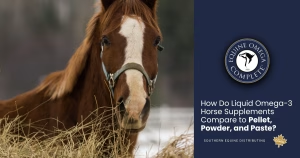Is your horse “just getting old,” or has their usual spark dimmed ever so slightly? Perhaps they’re a little “off,” but you can’t quite put your finger on why. As horse owners, we’re masters of observation, but sometimes the most impactful changes are the ones that whisper rather than shout. This isn’t about obvious lameness or a raging fever; it’s about a more insidious threat: chronic inflammation.
Think of acute inflammation as a fire alarm blaring – a sudden, clear signal that something is wrong, like a swollen joint after an injury. Your vet quickly identifies the problem, and you address it. Chronic inflammation, however, is more like a silent, smoldering fire. It’s a low-grade, persistent immune response that slowly erodes your horse’s health, often without the dramatic symptoms we’ve been taught to look for. It’s a silent fire that, left unchecked, can lead to serious health issues down the line, from metabolic disorders to joint degeneration.
It’s easy to dismiss these quiet cues as just part of aging or a bad mood, but learning to recognize them can be a game-changer for your horse’s long-term well-being. By empowering yourself with this knowledge, you can become your horse’s most vigilant advocate.
Understanding the “Silent Fire”: Acute vs. Chronic Inflammation
Before we dive into the subtle signs, let’s briefly clarify what we’re talking about.
- Acute Inflammation: This is your horse’s body’s immediate, healthy response to injury or infection. Think of the classic signs: heat, swelling, pain, redness, and loss of function. It’s crucial for healing, bringing immune cells to the rescue. Once the threat is gone, acute inflammation resolves.
- Chronic Inflammation: This is where the immune system remains “on alert” long-term, even when there’s no immediate danger. It’s a persistent drizzle eroding a pathway, rather than a sudden storm. This can be triggered by many factors, including diet imbalances, environmental stressors, obesity, and even ongoing low-grade infections. Unlike acute inflammation, chronic inflammation often presents with vague, non-specific symptoms that are easy to overlook.
The challenge lies in the subtlety. These aren’t the dramatic five cardinal signs of inflammation – redness, heat, swelling, pain, and loss of function; they are quiet clues that, when pieced together, can tell a powerful story about your horse’s internal health.
The 7 Subtle Signs Your Horse Might Be Experiencing Chronic Inflammation
Let’s explore the specific, often-overlooked indicators that can signal an underlying inflammatory process. These are the whispers, not the shouts, so keen observation is key.
1. Atypical Stiffness or “Warm-Up” Time
Have you noticed your horse taking longer to “work out of it” at the beginning of a ride or after standing for a while? This isn’t just normal age-related stiffness. While many horses may need a few minutes to warm up, a horse experiencing chronic inflammation might show a more pronounced reluctance to move, an unwillingness to bend, or a noticeable change in their gait during the initial minutes of exercise. They might seem “off” but then improve significantly as they move, making it easy to dismiss.
- The Subtlety: It’s not a head bob or obvious lameness. It’s a subtle awkwardness, a slight resistance, or needing five extra minutes of walking before they feel truly limber. Owners often attribute this to “just being stiff” or “cold backed.”
- The “Why”: This can signal early joint discomfort, muscle tissue inflammation, or even a systemic dullness that makes movement less appealing. Low-grade inflammation in joints or connective tissues can make initial movement uncomfortable until synovial fluid has a chance to lubricate, and muscles warm up.
2. Subtle Behavioral Changes
Has your usually calm mare become inexplicably grumpy during grooming? Or perhaps your energetic gelding seems a bit more withdrawn or anxious lately? Behavioral shifts are often the first, and most easily dismissed, signs of chronic discomfort. Chronic inflammation can cause a persistent, low-grade feeling of being unwell, which often manifests as irritability, increased anxiety, unusual lethargy, or a general “grumpiness” that isn’t typical for your horse.
- The Subtlety: This isn’t a sudden buck or rearing episode, but rather a slight intolerance, a lowered head, pinned ears more often than usual, or a reluctance to engage. Owners might call them “moody” or “off their game.”
- The “Why”: Constant systemic inflammation can affect neurological pathways and overall comfort, leading to a lowered pain threshold, increased stress, and a general feeling of malaise.
3. Dull, Dry Coat or Poor Hoof Quality
A shiny coat and healthy hooves are often reflections of good internal health. If your horse’s coat appears dull, dry, or even slightly flaky despite a balanced diet, proper grooming, and the season, it could be a subtle indicator. Similarly, hooves that become brittle, crack easily, or struggle to hold shoes without an obvious external cause might be telling you something.
- The Subtlety: This isn’t a sudden skin condition or laminitis. It’s a gradual loss of luster, a coat that just doesn’t quite “bloom” like it used to, or hooves that require more frequent attention than before. Owners might blame the weather or a “poor shed.”
- The “Why”: Chronic inflammation diverts the body’s resources away from non-essential functions like maintaining a vibrant coat and strong hooves. It can also impair nutrient absorption and utilization, even if the diet is seemingly complete. Essential fatty acids, crucial for skin and coat health, can also be affected by inflammatory processes.
4. Mild, Persistent Digestive Upset
The horse’s gut is a powerful engine, and any persistent disruption can signal underlying inflammation. This might manifest as mild, recurrent episodes of loose stool, excessive gas, or slight bloat that comes and goes. An inconsistent appetite, where your horse is picky one day and fine the next, without an obvious reason, can also be a clue. These aren’t emergency colic symptoms, but rather a nagging, low-grade irritation.
- The Subtlety: It’s not violent colic, but rather a general “uneasiness” in the gut, often mistaken for sensitive digestion or a change in hay. Owners might just accept a slightly soft stool as “normal” for their horse.
- The “Why”: The gut-inflammation axis is critical. Chronic low-grade inflammation in the digestive tract (leaky gut) can impair nutrient absorption and cause discomfort. Dietary imbalances, particularly high NSC (non-structural carbohydrates) diets, can fuel this inflammation.
5. Unexplained Weight Fluctuations or Difficulty Maintaining Condition
Is your horse struggling to keep weight on, even with seemingly adequate feed? Or perhaps they’re gaining weight easily, despite a controlled diet and exercise regimen? Both ends of the spectrum can be subtle indicators of chronic inflammation impacting metabolism. When the body is constantly battling inflammation, its metabolic processes can become disrupted, affecting how it uses energy and nutrients.
- The Subtlety: It’s not starvation or sudden obesity. It’s a struggle to find the “sweet spot” for their weight, or a slow, persistent drift despite efforts. Owners might blame the feed brand or a minor pasture change.
- The “Why”: Chronic inflammation can lead to insulin dysregulation, making it harder for the body to manage blood sugar and utilize energy efficiently. This can contribute to both weight gain (especially in horses prone to metabolic issues) and, paradoxically, difficulty gaining weight if inflammation is impairing digestion and nutrient absorption.
6. Slight Drop in Performance or Stamina
Your horse isn’t refusing fences or outright lame, but they just don’t have the same “zing” they used to. They might tire more quickly, show a slight reluctance to collect, or simply not perform with the same enthusiasm. This subtle decline often gets attributed to “laziness” or “age,” rather than a persistent underlying discomfort.
- The Subtlety: It’s not a sudden refusal or overt pain, but a general lack of enthusiasm, a shortened stride that isn’t quite right, or needing more encouragement than usual to maintain pace.
- The “Why”: Chronic inflammation can affect muscle recovery, joint comfort, and overall energy levels. The body is expending energy managing the inflammatory response, leaving less for peak performance. Even mild discomfort can inhibit a horse from giving their full effort.
7. Increased Sensitivity to Touch or Grooming
Does your horse flinch slightly more when you curry-comb their back or tighten the girth? Are there specific areas of their body where they seem unusually sensitive to touch, even without any visible injury or swelling? This heightened sensitivity, especially over the back, loin, or flank, can be a subtle sign of underlying musculoskeletal inflammation or general discomfort.
- The Subtlety: It’s not a violent reaction, but a subtle tightening, a slight dip, a quick ear pin, or a shift in weight in response to normal touch. Owners might think their horse is just being “girthy” or “ticklish.”
- The “Why”: Persistent, low-grade inflammation in muscles, fascia, or nerve endings can lead to a heightened sense of pain and discomfort. The body is trying to tell you that this area is sensitive and potentially inflamed, even if no outward swelling is present.
Beyond the 7 Signs: The Bigger Picture
Recognizing these subtle signs is the first step. Understanding the “why” behind them empowers you further.
- The Gut-Inflammation Connection: A significant portion of your horse’s immune system resides in their gut. An unhealthy gut, sometimes termed “leaky gut,” can allow toxins and undigested food particles to enter the bloodstream, triggering a systemic inflammatory response. This can manifest in many of the subtle signs we’ve discussed.
- Dietary Triggers: Modern equine diets, often high in non-structural carbohydrates (NSC) and imbalanced omega-3 to omega-6 fatty acid ratios, can be pro-inflammatory. Reducing NSC and optimizing omega ratios (more omega-3s) can be a powerful strategy in managing chronic inflammation..
- Environmental & Stress Factors: Chronic stress, exposure to environmental toxins (like mold or certain chemicals), and even over-vaccination can contribute to the body’s inflammatory burden. A holistic approach considers these factors in your horse’s overall health.
When to Call the Vet
While these signs are subtle, they are not a substitute for veterinary diagnosis. If you’re consistently observing a cluster of these symptoms, it’s time to gather your notes and consult your veterinarian. Providing them with a detailed log of your observations – when you noticed the change, how often it occurs, and any other relevant factors – will be invaluable in helping them conduct a thorough examination. They may recommend diagnostics such as blood work (looking at inflammatory markers like CRP or SAA), imaging, or other tests to pinpoint the underlying cause.
FAQ: Your Questions About Chronic Equine Inflammation Answered
Q: What’s the main difference between acute and chronic inflammation in horses?
A: Acute inflammation is a short-term, necessary healing response with obvious signs like heat, swelling, and pain. Chronic inflammation is a long-term, low-grade immune response that persists, often without dramatic symptoms, and can slowly damage tissues over time.
Q: Can a horse be “just stiff with age,” or is it always chronic inflammation?
A: While some age-related stiffness is normal, a significant or worsening stiffness that “warms out” or is consistently present could indicate underlying chronic inflammation in joints or soft tissues. It’s always best to investigate to differentiate between normal aging and a treatable condition.
Q: How quickly can I expect to see changes if I start addressing chronic inflammation?
A: This varies greatly depending on the cause and severity of the inflammation. With dietary changes and appropriate management strategies, some owners report seeing subtle improvements in coat quality, energy levels, or digestive comfort within a few weeks to a couple of months. Consistent, long-term commitment is key.
Q: Is it safe to give my horse over-the-counter anti-inflammatory medications if I suspect chronic inflammation?
A: It’s crucial to consult your veterinarian before administering any medications, including over-the-counter options. Masking symptoms without addressing the root cause can lead to more serious issues. Your vet can provide a proper diagnosis and recommend the safest and most effective treatment plan.
Q: What role does nutrition play in managing chronic inflammation?
A: Nutrition plays a profound role! Diets high in pro-inflammatory omega-6 fatty acids (found in many grains and vegetable oils) and high in sugar/starch (NSC) can fuel inflammation. Conversely, a diet rich in anti-inflammatory omega-3 fatty acids, balanced nutrition, and supportive gut health can significantly help manage and reduce chronic inflammation.
Empowering Your Horse’s Health Journey
Recognizing the subtle signs of chronic inflammation in your horse is a powerful step towards proactive health management. You are the one who knows your horse best, and your keen observation skills can be their first line of defense. By noticing these quiet whispers, you can intervene early, in partnership with your veterinarian, and help your horse live a more comfortable, vibrant, and healthy life.
Don’t dismiss those small changes. Pay attention, document what you see, and trust your instincts. Your horse is counting on you, and we are here to help.





